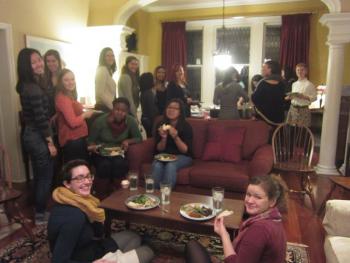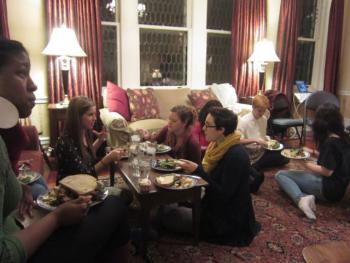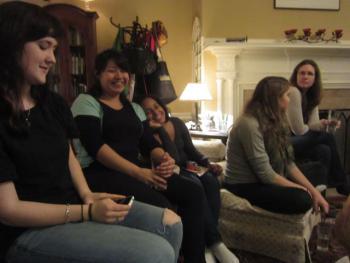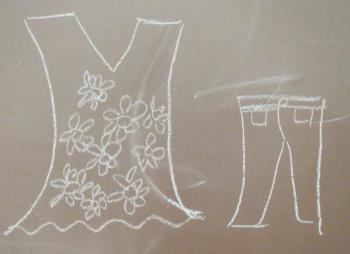Serendip is an independent site partnering with faculty at multiple colleges and universities around the world. Happy exploring!

Reflections on the Perry House Couch
To see our videos, go to www.perryhousecouch.tumblr.com ! Feel free to ask us more questions, comment on our videos, etc.
When I first heard that we were going to be doing final activism projects for this 360 instead of just a term paper or something straightly academic, I was thrilled. I feel as though I left our classroom spaces often unsure of myself or of what to make of what had just been said, and at the same time, feeling as though it had been made abundantly clear just how much work we need to do in the world to make it fairer and more just. In trying to keep myself in touch with the larger picture and the bigger world around me, I often remind myself that I’m just a tiny little piece of an enormous universe full of people, stories, history, happiness, injustices, triumphs and mistakes. But sometimes, this keeps me from feeling as though what I do has much impact at all. I worry that my efforts will not reach far enough, won’t attract enough attention, or won’t be effective. As much as I love being involved as an activist on and off campus, and try to do so as much as possible, I do sometimes feel as though it’s not enough. Throughout this class experience, though, it’s been reinforced for me that it really isn’t about me, or my comfort, or my self-esteem. I can’t use my lack of confidence or fear that my actions will lack efficacy as an excuse to shy away from doing my best, or feeling like the work that I’ve already done or plan to do has purpose and a positive impact.

Memo 3
 I ended up writing my memo on the various changes of the program, mostly on what could have happened if we ended up in FDC and how our class ended up adjusting and working out with the Cannery. And I like this image cause it shows how the paths have no end, which is how I feel like our journey with this course will be for a long while. At least for me, I have no idea when it will all come full circle for me.
I ended up writing my memo on the various changes of the program, mostly on what could have happened if we ended up in FDC and how our class ended up adjusting and working out with the Cannery. And I like this image cause it shows how the paths have no end, which is how I feel like our journey with this course will be for a long while. At least for me, I have no idea when it will all come full circle for me.

Thinking about Teaching Writing
Or Graduate School Application Responses...
The good writing teacher helps students express ideas clearly and concisely through writing in the form appropriate to their discipline. The great writing teacher helps students develop the relationship between their thinking and their writing. The purpose of student writing assignments is not a regurgitation of the material the teacher feed to the class. It is to continue a conversation started in class and reading assignments. While the teacher may initiate the conversation, it is the students’ responsibility to extend the classroom discussion with their own insights. Students are supposed to learn about the relationship of words to ideas.
Even in the work of the best writers, words fail a little. Words always incompletely capture the world. Acknowledging the limitations of language is essential to the practice of writing and interpreting. However, the gap between intention and interpretation is where real learning occurs, for the writer and the teacher too. As the technique of the writer improves, the gap decreases. It is the work of the student and the teacher together to bridge that gap. The teacher should deploy a variety of strategies to help the student realize their ideas in their writing. Repeated revisions, experimentation with form, and face-to-face conversations are some good methods. This story about teaching writing holds true across all disciplines.

Diffracting: Reflections on Ecolit
I spent the summer before fall semester excited to take Ecological Imaginings, a class I described to my friends and family as an ecological English class that was somehow connected to feminism. That is still how I view the class, though now I have more of an idea 1) what ecological English is and 2) how feminism is connected to the environment. The beginning of the class was structured very well for the way that I learn. I learn through doing things- through moving my body, and exploring things in my own time. The first ecological ramble was suited very well for this kind of learning. I enjoyed looking at Bryn Mawr’s campus through new eyes and then writing about this experience. For my site sits I always spent at least an hour outside and wrote about whatever seemed pertinent about the experience at the time.

Standing on Walls
I just wanted to share the video Dan and I did for our final project! We encourage you to share it with all your friends and hope it will spark some really necessary and useful conversation. Enjoy!

The Brain-Gut-Heart Connection
As I return to school as a McBride Scholar, forty-plus years after breaking off my last bout of formal education, my learning goals and tasks are bound to be somewhat different from those of my freshman classmates. Part of my job in our Ecological Imaginings ESEM was to begin to discover a new identity, in this odd situation where my age is more than three times that of others in the class; and to figure out how to position myself in relation to (1) my own past and future, (2) the expectations of my teacher and of the college, and (3) my peers in the class, so similar to and so different from my own selves of long ago, and of now. I have found this rather a complicated dynamic, to put it mildly.













